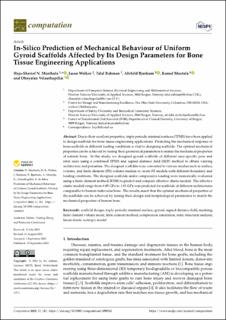| dc.contributor.author | Nazimutheen Musthafa, Haja Sherief | |
| dc.contributor.author | Walker, Jason | |
| dc.contributor.author | Rahman, Talal | |
| dc.contributor.author | Bjørkum, Alvhild Alette | |
| dc.contributor.author | Mustafa, Kamal Babikeir Elnour | |
| dc.contributor.author | Velauthapillai, Dhayalan | |
| dc.date.accessioned | 2023-09-22T12:16:04Z | |
| dc.date.available | 2023-09-22T12:16:04Z | |
| dc.date.created | 2023-09-15T10:26:22Z | |
| dc.date.issued | 2023 | |
| dc.identifier.issn | 2079-3197 | |
| dc.identifier.uri | https://hdl.handle.net/11250/3091391 | |
| dc.description.abstract | Due to their excellent properties, triply periodic minimal surfaces (TPMS) have been applied to design scaffolds for bone tissue engineering applications. Predicting the mechanical response of bone scaffolds in different loading conditions is vital to designing scaffolds. The optimal mechanical properties can be achieved by tuning their geometrical parameters to mimic the mechanical properties of natural bone. In this study, we designed gyroid scaffolds of different user-specific pore and strut sizes using a combined TPMS and signed distance field (SDF) method to obtain varying architecture and porosities. The designed scaffolds were converted to various meshes such as surface, volume, and finite element (FE) volume meshes to create FE models with different boundary and loading conditions. The designed scaffolds under compressive loading were numerically evaluated using a finite element method (FEM) to predict and compare effective elastic moduli. The effective elastic moduli range from 0.05 GPa to 1.93 GPa was predicted for scaffolds of different architectures comparable to human trabecular bone. The results assert that the optimal mechanical properties of the scaffolds can be achieved by tuning their design and morphological parameters to match the mechanical properties of human bone.
Keywords: scaffold design; triply periodic minimal surface; gyroid; signed distance field; meshing; finite element volume mesh; finite element method; compression simulation; static structural analysis; linear elastic isotropic model | en_US |
| dc.language.iso | eng | en_US |
| dc.publisher | MDPI | en_US |
| dc.rights | Navngivelse 4.0 Internasjonal | * |
| dc.rights.uri | http://creativecommons.org/licenses/by/4.0/deed.no | * |
| dc.title | In-Silico Prediction of Mechanical Behaviour of Uniform Gyroid Scaffolds Affected by Its Design Parameters for Bone Tissue Engineering Applications | en_US |
| dc.type | Peer reviewed | en_US |
| dc.type | Journal article | en_US |
| dc.description.version | publishedVersion | en_US |
| dc.rights.holder | © 2023 by the authors | en_US |
| dc.source.volume | 11 | en_US |
| dc.source.journal | Computation | en_US |
| dc.source.issue | 9 | en_US |
| dc.identifier.doi | 10.3390/computation11090181 | |
| dc.identifier.cristin | 2175403 | |
| dc.source.articlenumber | 181 | en_US |
| cristin.ispublished | true | |
| cristin.fulltext | original | |
| cristin.qualitycode | 1 | |

